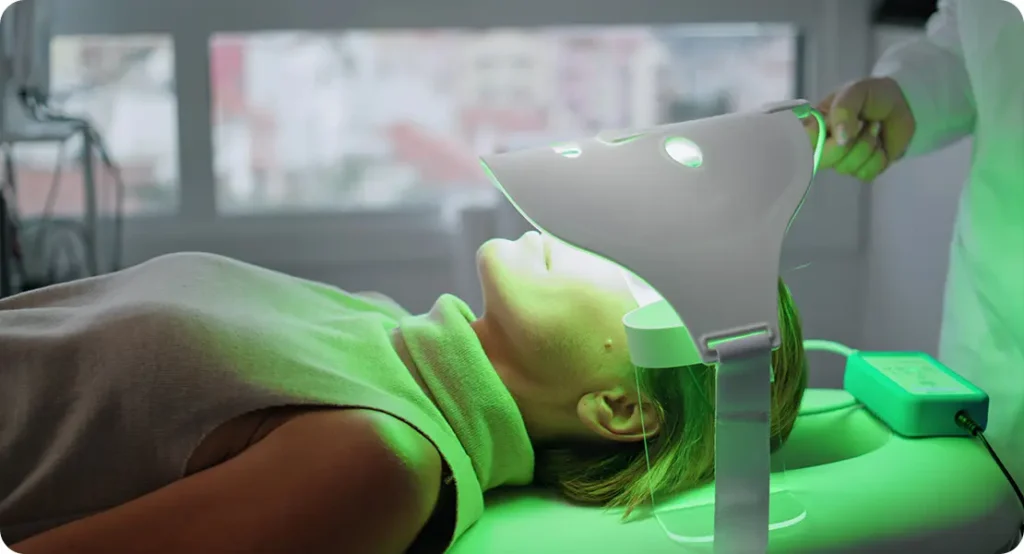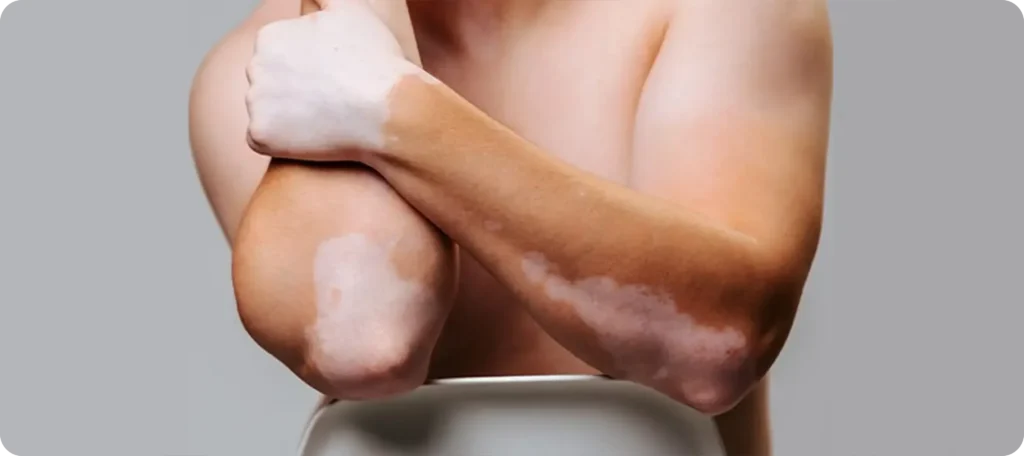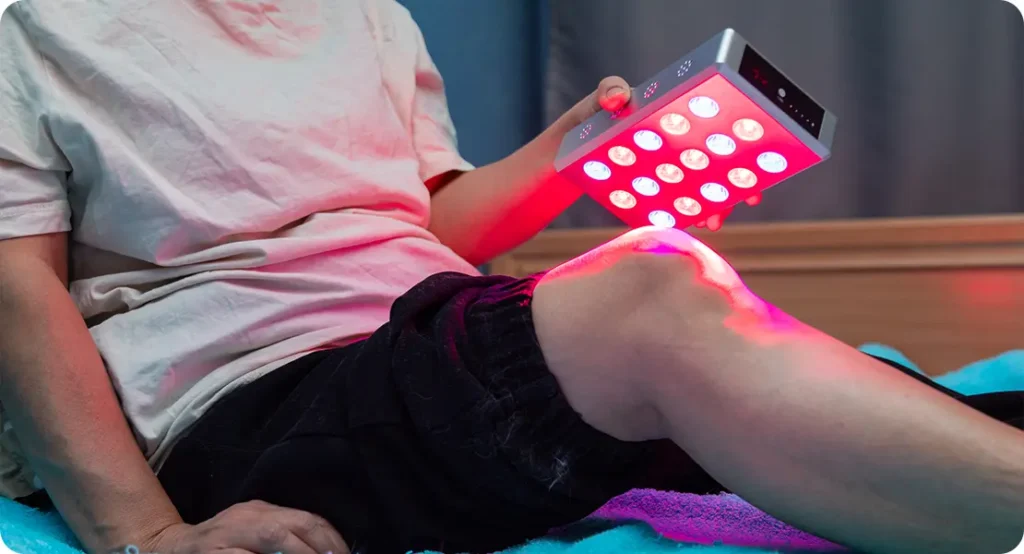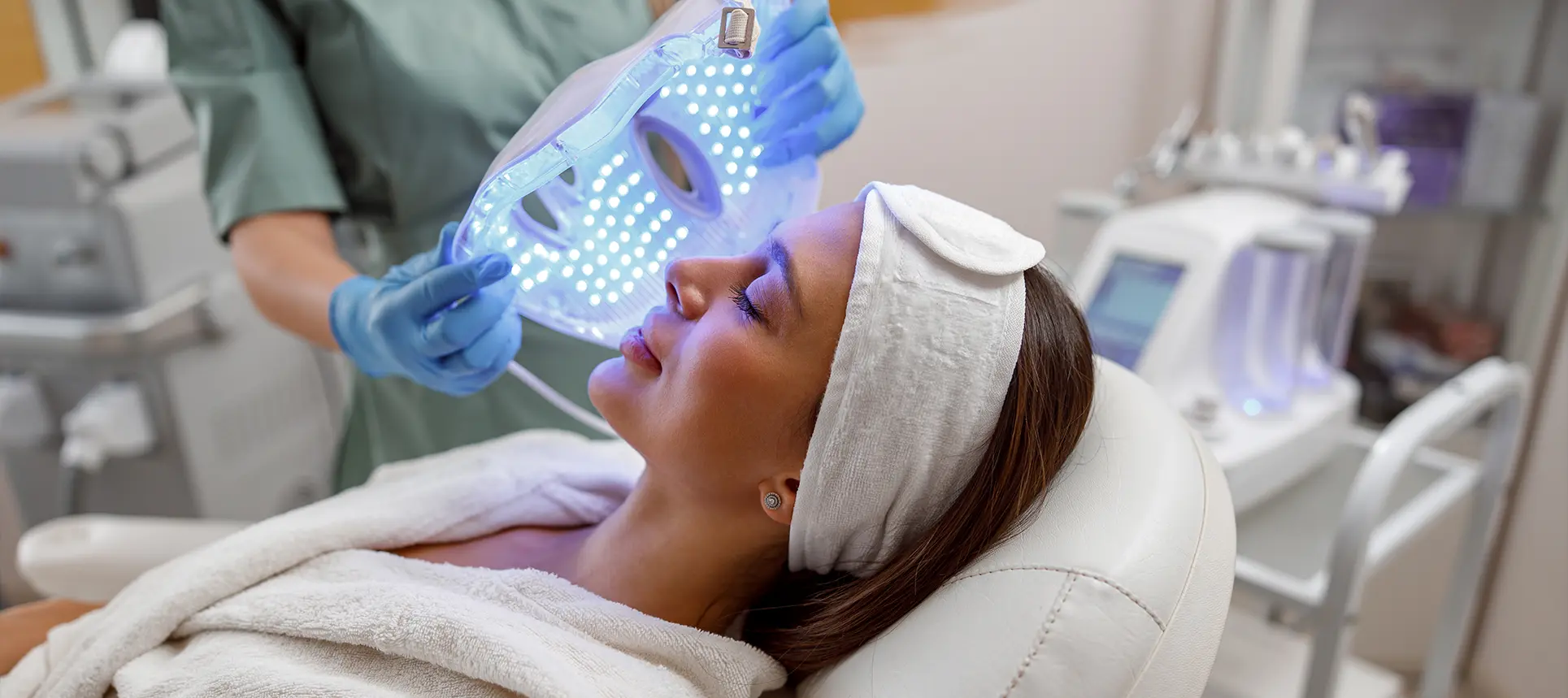If you’ve ever struggled with eczema, psoriasis, or vitiligo, you’ll know just how relentless these skin conditions can be. The itching, the discomfort, and the visible patches can make even simple everyday activities feel overwhelming. And while creams and medications often provide some relief, there’s another powerful treatment that’s often overlooked: light therapy, also known as phototherapy.
In this guide, we’ll walk you through exactly how dermatologists use light therapy—particularly narrowband UVB—to treat eczema, psoriasis, and vitiligo. We’ll break down how it works, what the treatment process looks like, and what you can expect if you’re considering it as part of your skin care journey.
What Is Light Therapy and How Does It Work?
Let’s start with the basics. Phototherapy is a form of treatment that uses specific wavelengths of ultraviolet (UV) light to treat a variety of skin conditions. The most commonly used type in dermatology today is narrowband UVB therapy.
So, what does “narrowband UVB” actually mean? It refers to a very specific range of ultraviolet B light—specifically 311 to 313 nanometres. This range has been found to be the most effective for treating inflammatory skin diseases while causing the fewest side effects.
The light works by calming down the immune system’s response in the skin. In conditions like psoriasis and eczema, the immune system is overactive and causes inflammation. With vitiligo, it’s the immune system mistakenly attacking pigment-producing cells. Narrowband UVB slows down or stops this process, giving the skin a chance to heal, repigment, or become less inflamed.
Why Narrowband UVB Is Preferred Over Other Light Types
There are different types of UV light—UVA, UVB, and even broadband versions of both. But narrowband UVB has become the gold standard for many dermatologists. Why? Because it strikes the right balance between effectiveness and safety.
Broadband UVB was used in the past, but it included a wider range of wavelengths, some of which were more likely to cause burning or increase long-term skin damage. Narrowband UVB removes most of those risks while keeping the therapeutic benefits.
UVA light, on the other hand, is sometimes used in combination with psoralen (in what’s called PUVA therapy), but it carries a higher risk of side effects and is typically reserved for more severe cases or when narrowband UVB doesn’t work.
What to Expect During a Phototherapy Session
If your dermatologist recommends phototherapy, your treatment will usually take place in a specialist clinic or hospital outpatient setting. Here’s what the process typically looks like:
You’ll stand in a large booth, a bit like a vertical tanning machine, lined with UVB-emitting bulbs. You’ll be given protective goggles to shield your eyes and, in some cases, a covering for sensitive areas like the genitals.

The first session will be very brief—just a few seconds to a minute—depending on your skin type. Over time, the exposure increases gradually. Most people attend treatment two to three times a week, with each session lasting just a few minutes.
A full course may involve 20 to 30 sessions, though some people may require more or fewer depending on their skin’s response. It’s a cumulative treatment, meaning results build up over time.
Light Therapy for Psoriasis: Calming the Overactive Skin
Psoriasis is perhaps the most well-known condition treated with narrowband UVB. The hallmark of psoriasis is the rapid turnover of skin cells, leading to thick, scaly patches that can appear anywhere on the body.
Phototherapy works by slowing down that rapid cell production. It reduces inflammation, minimises itching, and helps clear up plaques. Many patients start to see improvement within a few weeks of starting treatment.
Unlike topical steroids, which can thin the skin with long-term use, UVB light doesn’t cause this issue. And for people who don’t respond well to creams or can’t tolerate systemic medications, light therapy offers a safer, effective alternative.
It’s also a good option for widespread psoriasis where applying creams to large surface areas becomes impractical. Light therapy can target the whole body in just a few minutes, making it much more manageable for daily life.
Eczema and UVB: A Relief from the Constant Itch
Eczema, also known as atopic dermatitis, is a chronic inflammatory condition that causes dry, itchy, and cracked skin. It can come and go in flares, and it often affects children as well as adults.
For people with moderate to severe eczema that doesn’t improve with moisturisers and steroid creams, light therapy can be a game-changer. It helps by reducing inflammation in the skin and slowing down the immune system’s response that leads to those itchy patches.
Patients often report not just visual improvement, but a major reduction in the itch—one of the most debilitating symptoms of eczema. And fewer flare-ups mean better sleep, improved mood, and better overall quality of life.
Narrowband UVB is especially useful when eczema affects large areas of the body, and in cases where steroids are causing side effects or can’t be used for long stretches.
Treating Vitiligo with Light Therapy: Restoring Skin Pigment
Vitiligo is a condition where patches of skin lose their pigment, turning white due to the destruction or malfunction of melanocytes, the cells that produce pigment. It’s not dangerous, but it can be emotionally and socially challenging, especially when it appears on the face or hands.
Light therapy offers one of the best chances of repigmentation, particularly when treatment starts early. The UVB light stimulates the remaining melanocytes and helps them multiply and migrate back into the affected areas of skin.

It’s not a quick fix—re-pigmentation takes time and may require months of consistent treatment. But many people see patches of colour gradually return, often starting from the hair follicles outwards.
Phototherapy is particularly effective for vitiligo on the face and upper body. Areas like hands and feet tend to be more resistant, but results can still be seen with perseverance and combination treatments.
Is It Safe? Understanding the Risks and Side Effects
One of the biggest concerns people have with light therapy is whether it’s safe. After all, we’re constantly told to protect our skin from UV rays—so how can exposure be beneficial?
The key difference is control. In phototherapy, the UV exposure is carefully measured and delivered in a medical setting, unlike sunbathing which can cause unpredictable and uneven exposure.
Short-term side effects are usually mild and may include temporary redness, itchiness, or dryness. Some people experience a mild sunburn-like reaction if their skin is particularly sensitive, but this is usually resolved by adjusting the dose.
Long-term risks, such as premature skin ageing or increased skin cancer risk, are much lower with narrowband UVB than with PUVA or broadband UVB. Dermatologists monitor your cumulative UV dose over time to ensure it’s within safe limits.
How Light Therapy Compares to Other Treatments
It’s natural to wonder how light therapy stacks up against other treatment options. Here’s a quick breakdown:
- Topical treatments: These are often the first line of defence. While effective for many, they can be messy, hard to apply to large areas, and lose efficacy over time. Light therapy works well when creams aren’t enough.
- Systemic medications: For severe cases, drugs like methotrexate, ciclosporin, or biologics are used. These can be very effective but come with higher risks and require regular blood tests. Light therapy offers a middle ground—stronger than creams but safer than tablets.
- Natural sunlight: Yes, sunlight contains UVB too—but it’s hard to control, and there’s always the risk of sunburn. Phototherapy gives you the benefits of UV without the unpredictability.
Ultimately, the best approach depends on your individual case. Your dermatologist will weigh the benefits and risks and tailor the plan accordingly.
Who Is and Isn’t a Good Candidate for Light Therapy?
Most people with moderate to severe eczema, psoriasis, or vitiligo can benefit from narrowband UVB. But it’s not for everyone.
If you have a history of skin cancer, light sensitivity disorders, or are on medications that increase UV sensitivity, your dermatologist may advise against it. Pregnant women and young children are usually treated with extra caution too.
That said, phototherapy can often be adjusted or modified—for instance, by targeting only specific body areas or reducing session frequency—to accommodate different needs.
It’s also worth mentioning that commitment is key. Since treatment typically requires 2–3 visits per week over several months, it can be time-consuming. You’ll need to weigh whether you can realistically stick to the schedule.
Home Phototherapy: Is It an Option?
Yes, in some cases, dermatologists may recommend home phototherapy units for patients who’ve responded well in clinic but need long-term maintenance. These units are specially designed for safe use outside the clinical setting and are typically available as portable hand-held devices or larger cabinet-style units for full-body treatment. They emit the same narrowband UVB light used in medical facilities but on a scale that’s appropriate for unsupervised use at home. For patients with chronic skin conditions who face logistical challenges travelling to frequent appointments, home phototherapy can be a practical solution.

The biggest advantage of home treatment is the flexibility it offers. You’re able to carry out your sessions in your own time, which can make it easier to stick to a treatment plan. However, using the equipment correctly is essential. Settings must be followed exactly as prescribed, and it’s vital not to overexpose the skin. You’ll still need to maintain regular contact with your dermatologist to assess your skin’s response, ensure you’re on the correct dosage schedule, and avoid any side effects from overuse. Many clinics will require a period of in-clinic phototherapy before transitioning a patient to home use.
That said, not everyone is a suitable candidate for home phototherapy. Patients must be reliable, consistent, and able to follow detailed instructions without supervision. A poor understanding of the risks or misuse of the equipment can result in burns, ineffective treatment, or even increased skin damage over time. Your medical history, skin type, and condition severity will all be taken into account before a dermatologist agrees to prescribe a home unit. It’s a great option when used responsibly—but it’s not a shortcut, and it certainly doesn’t replace professional care.
Combining Light Therapy with Other Treatments
Light therapy doesn’t have to work alone. In fact, it’s often more effective when combined with other therapies tailored to your skin’s specific needs. Dermatologists regularly take a multi-pronged approach, especially in cases where a single treatment hasn’t delivered adequate relief. The combination of narrowband UVB with topical, systemic, or natural remedies can create a more balanced and comprehensive treatment plan that addresses both symptoms and underlying inflammation.
For example, in psoriasis, UVB treatment may be paired with vitamin D analogues like calcipotriol or even tar-based products to boost response rates. These combinations help reduce thickness and scaling more rapidly. In eczema, a base layer of moisturisers before light exposure can improve skin hydration and increase comfort during and after treatment. Anti-inflammatory creams or ointments may also be introduced during flare-ups to reinforce the immune-calming effects of UVB. With vitiligo, light therapy can be supported by topical agents like tacrolimus or corticosteroids to enhance pigment restoration, particularly when used in the early stages.
The order and timing of each treatment are also crucial. Some creams can block UV absorption or make the skin more sensitive to light, so your dermatologist may advise when to apply them—either before or after your session. In some cases, certain agents need to be paused temporarily during phototherapy. Following professional instructions closely helps ensure you get the full benefit of the combined treatment plan while minimising any risks of irritation or reduced efficacy. The end goal is always to find the most sustainable routine that works for your condition and lifestyle.
Managing Expectations: What Results Can You Expect?
Here’s the truth: light therapy isn’t a quick fix. It requires commitment and patience, especially in the early weeks when results might be subtle. Unlike some treatments where you might see rapid changes, UVB phototherapy works gradually by adjusting the immune response in your skin. For some, the changes appear slowly but steadily; for others, it may take a few months before noticeable improvements are seen. But if you stick with it, the benefits can be incredibly rewarding—not just physically, but emotionally too.
People with psoriasis often begin to see smoother skin and reduced plaque build-up after about 10 to 15 sessions, with more significant clearance usually happening by the 20th or 30th treatment. Eczema sufferers may find that itchiness and redness start easing after a few weeks, which can lead to better sleep and a noticeable improvement in quality of life. Vitiligo patients, who typically require more extended treatment, may begin to observe the return of pigmentation in small patches—especially on the face—within two to three months. The timeline varies from person to person, and progress tends to be more gradual on hands, feet, and joints.
That said, it’s important to be realistic. Results from light therapy are rarely permanent without continued care. Some people will require maintenance sessions every few weeks or months to keep symptoms at bay. Others might combine phototherapy with other long-term strategies, such as lifestyle adjustments or topical treatments, to maintain control. But when you compare this with the potential side effects of long-term systemic medications, light therapy often provides a gentler, safer option that many find worth the time investment. Managing expectations doesn’t mean lowering them—it means understanding what’s achievable and staying consistent to get there.
Final Thoughts: Could Light Therapy Be Right for You?
If you’re struggling with eczema, psoriasis, or vitiligo that isn’t responding well to conventional treatments, light therapy could be the next step worth exploring. It’s safe, clinically proven, and surprisingly effective when done under expert guidance.
You don’t have to live with the daily frustration of itching, flaring, or depigmented skin. With phototherapy, there’s real hope—not just for symptom relief, but for getting your confidence and comfort back.
So, speak to your dermatologist and ask whether narrowband UVB might be right for your skin. Sometimes, all it takes is a little light to make a big difference. If you would like to learn more about light therapy to treat your skin condition, you can get in touch with us at The London Dermatology Centre to book a consultation with one of our expert dermatologists.
References
- NHS, 2023. Phototherapy for skin conditions. NHS.
- Cameron, H., Yule, S., Moseley, H. and Ferguson, J., 2002. Taking treatment to the patient: development of a home TL-01 ultraviolet B phototherapy service. British Journal of Dermatology, 147(5), pp.957–965.
Available at: https://onlinelibrary.wiley.com/doi/full/10.1046/j.1365-2133.2002.04968.x - British Association of Dermatologists (BAD), 2020. Phototherapy (Light Treatment). Patient Information Leaflet.
Available at: https://www.bad.org.uk/pils/phototherapy/ - George, S., Hamzavi, I.H. and Lim, H.W., 2008. Narrowband ultraviolet B phototherapy for the treatment of vitiligo: A review. Dermatologic Surgery, 34(5), pp.587–592.
Available at: https://journals.lww.com/dermatologicsurgery/Abstract/2008/05000/Narrowband_Ultraviolet_B_Phototherapy_for_the.3.aspx - NICE, 2017. Psoriasis: assessment and management. National Institute for Health and Care Excellence (NICE) Clinical Guideline CG153.
Available at: https://www.nice.org.uk/guidance/cg153
